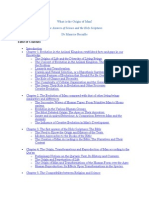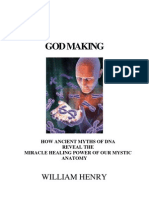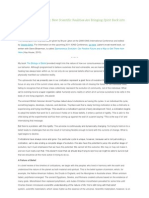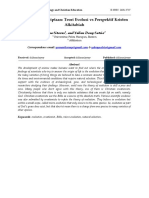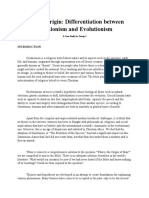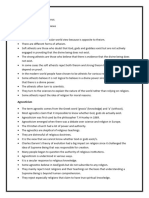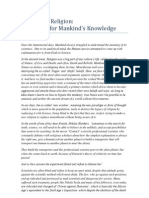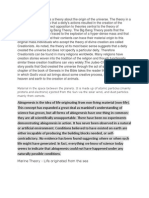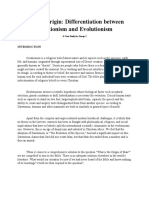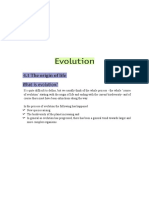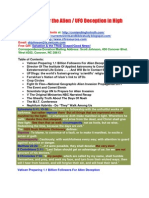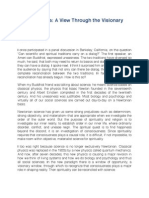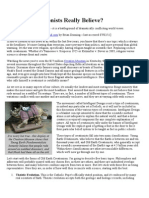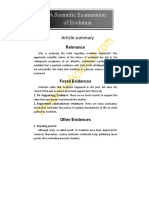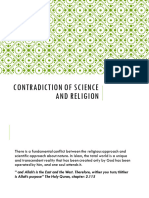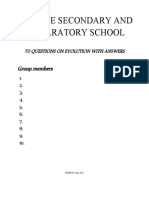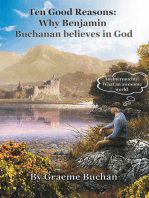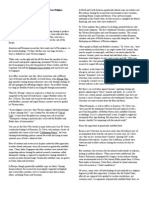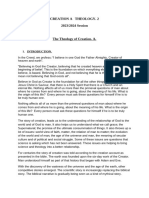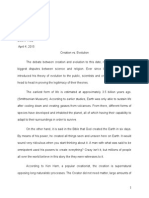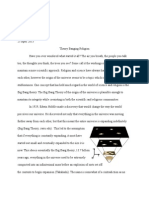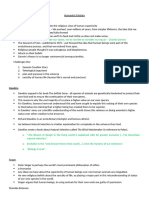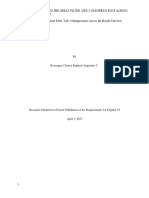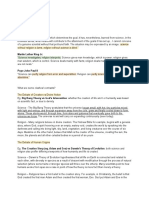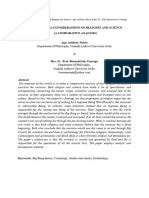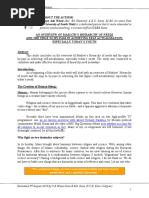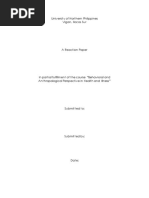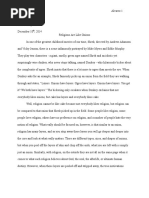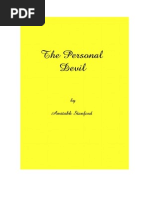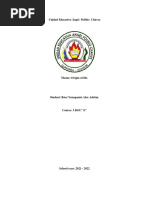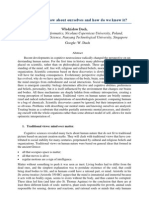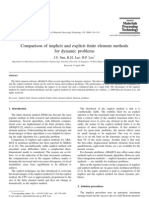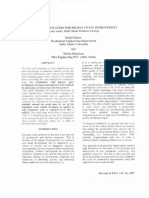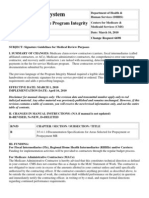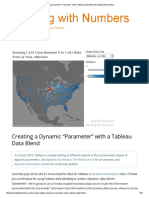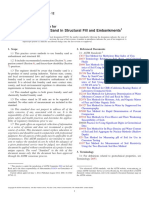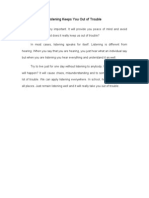Ima Imoinu
Ima Imoinu
Uploaded by
nirpen8587Copyright:
Available Formats
Ima Imoinu
Ima Imoinu
Uploaded by
nirpen8587Original Title
Copyright
Available Formats
Share this document
Did you find this document useful?
Is this content inappropriate?
Copyright:
Available Formats
Ima Imoinu
Ima Imoinu
Uploaded by
nirpen8587Copyright:
Available Formats
The Resurrection of Ima Imoinu
Dr Irengbam Mohendra Singh January 15 2010
The resurrection of Ima Imoinu, the goddess of wealth has important spiritual meanings for the Meiteis in as much as the resurrection of Christ has for the Christians. Both are belief systems. This is the bicentenary year of the birth of Charles Darwin and 150 years since his publication of The Origin Of Species. Within the last 150 years, certain fundamentalist Christian groups in the United States have been trying to establish creationism to challenge the rise of Darwinism. In the 1960s there was development of the Creation science movement. It was an attempt to find geological evidence for Bible stories like Noahs Ark and flood recounted in Genesis. Having failed, there was the emergence of Intelligent Design theory in the 1980s. It looked for design in the world and presented as evidence of an Intelligent designer. It attempted to provide arguments against evolution with its missing links. The present world-view of the existence of this planet is divided between the believers of God (Creationists) and evolutionists (Darwinians). The supporters of intelligent design argue that the fact that the universe is fit for life requires explanation but an appeal to chance is no explanation at all. It is far more likely that that the universe was initiated by a being (God) that intended to create a universe that could support life. This can only be explained with reference to a Creator with an intelligent design. The evolutionists argue that the rate of expansion of the universe after the Big Bang was just right to allow life to develop. Had the rate of expansion been too fast the gravity would not have a chance to pull any of the pieces of matter together to form planets, stars and even gases. There would not have been anything for life to emerge from. The intelligent design is very strongly denied by Richard Dawkins, a Darwinian Englishman. He says Creationism is a denial of physics, geology, cosmology, archaeology, history and chemistry as well. He cites a botch-job of the human eye, which is far from being an intelligent design; it is disastrously strung together back to front so that we have to look through a mass of nerves connecting the retina of the eye to the brain and all this visual wiring has run through a hole that literally gives a blind spot. Only the compensatory work done by the brain allows us to see with any semblance of clarity. He quotes another extravagant lack of forward planning (anti-intelligent design) that is evident in one of the nerves that links to the larynx of mammals. This recurrent laryngeal nerve takes an extraordinarily circuitous route, diving into the chest, looping round a coronary artery and then heading back up again. This nerve detours over 15ft in the giraffe, which is far from being an intelligent design. Here evolution provides answers. This nerve turns out to be descended from a far neater arrangement in the gills of fish. It was because the giraffes neck slowly lengthened over evolutionary times. Millions of people all over the world have long shared the belief that God created the universe and everything in it. Now the Young Earth Creationists, who believe that the earth is young, believe that the earth has existed for the last 6,000 years and each species was created separately by God. The creationists vary in their interpretation of how exactly God created the universe. Meanwhile, there is scientific evidence, which indicates that the planet and every species on it existed over 5,000 million years ago and all the species originated by natural
(2) selection ie by evolution. While the belief in the evolution theory is increasing worldwide, Americans deny evolution. In the UK where the opposite view prevails, in 2009 God has fallen from popularity at dinner time in the Newnham College, Cambridge University. The traditional Christian grace commonly used by the students before formal dinners held once a week was addressed to Jesus Christ our Lord. The new grace reads: For food in a hungry world, for companionship in a world of loneliness, for peace in an age of violence we give thanks. In Italy in 2006, a judge ordered a priest to appear in court to prove that Jesus Christ existed in a law suit filed by Signor Cascoli, the author of a book called The Fable of Christ against Father Enrico Right. Cascoli maintains that the early Christian writers confused Jesus with John of Gamal, an anti-Roman Jewish insurgent in the first century Palestine. He said that the Gospels themselves were full of inconsistencies and did not agree on the names of the 12 apostles. The Meitei religion of Sanamahi laining of which Ima Imoinu is a principal deity though basically an animistic belief has all the philosophies of the ancient world and they remain central to any modern conspectus of what philosophy is and can be. Meiteis believe in innumerable spiritual beings concerned with human affairs. These spirits are capable of helping or harming Meitei interests. Such beliefs exist among the tribal people and Schedule casteMeiteis in Manipur. All the major religions of the world contain some elements of animism but all the tribes and primitive people are animistic. This is because before the advent of modern smart religions with monotheism all the people in the world were animistic. Animism has not left the Meiteis despite their conversion to Hinduism. One such animistic belief is Hingchabi changba (possessed by female demon). The Hindu equivalent is nazar lagna or evil eye in Europe. This phenomenon is known as possessed (by evil spirit) in Christianity. It has been in existence since Roman times. Hingchabi changba is a superstition that a glance from someone with magic or supernatural powers can cause injury, misfortune and perhaps death. It is a medical condition known as hysterical conversion. It is a sociogenic illness characterised by dissociation, histrionics and alteration in psychomotor activity eg shaking, twisting and persisting contracture, and usually lasting from one day to few weeks. It will occur in certain people especially women or children with hysterical personality, just like hypnotism that can only be induced to certain susceptible people. The Meiteis also believe in shamanism, which is centred on shaman - a person (maibi) believed to achieve various powers through trance or ecstatic religious experience. It is generally agreed that shamanism originated among hunter-gatherer cultures as those of the Meitei ancients. Shamanism is a belief system in which the world is home to a plethora of spirit-beings such as the seven sisters of Heloi for the Meiteis that may help or harm human life. Where do these evil spirits come from? How did they first lurch into the human brain? Are they all around us? Primitive men invented evil spirits as the root cause of all their woes and miseries, ghastlier than terrifying predators that they could see. They remained lurking in the shadows of the human mind ever since. The Meiteis like all the major religions have the myth of creation (Lai haraoba), which is a symbolic narrative of the beginning of the world as understood by the Meiteis. All doctrines
(3) of creation are based on myth such as Genesis in the Bible and the New Creation in Jesus Christ. The creation myth expresses and embodies of all the fertile possibilities for thinking about the subject. The Meitei myth of creation refers to the process through which the Meitei world is centred and given a definite form of our existence from time before memory. They also serve as a basis for the orientation of the Meiteis in the world as a separate community. The Meteis also practise Ancestor worship, priti turpon in Hinduism. Ancestor worship is a spiritual expression in that those long dead ancestors have a continued and beneficial interest in the affairs of the living relatives. All human societies all over the world had some form of religion beginning from simple animism and ancestor worship through polytheism, monotheism, deism and currently, humanism. Humanists do not believe in God. They prefer the scientific theory of evolution. They say that God created everything just poses the question: Who created God? If God had a father the father must have had a father and so on. They accept responsibility for their own lives. They believe when they die they just die. As they do not recognise after-death the humanist funeral uniquely and affectionately celebrates the life of the person who has died. Proper tribute is paid to the life they lived, the connections they made and have left behind. While emphasising the importance in the study of culture and religion, which have survived in more complex and hierarchical way of life, modern scholarship concerns the need to understand a rational and scientific universe. Dr Craig Venter of Maryland in the US is now close to creating life after piecing together a giant DNA jigsaw. He completely synthesised a chromosome in 2007 and in January 2009 created the entire genetic code of a new bacterium. He now hopes to transfer such artificial DNA into a host cell to create new species. Scientists have discovered where the first life came from: from inorganic matter, literally fallen from the sky. Scientists at the University of Chicago experimented and reproduced amino acids, which are components of the nucleic acids DNA and RNA. DNA can replicate as it does in living cells. RNA carries genetic information from DNA where it can be used. This is called the RNA world theory of the origin of life. The theory of evolution, unlike creation is confusing for many. It is more so in one particular topic whether human beings descended from monkeys. The answer is humans are not descendents of monkeys/apes. We only share a common ancestor who would have looked like monkeys. That is why a chimpanzee cannot evolve into a human being. Our closest living relative is the Chimpanzee sharing 98% of our genes, whose ancestral line separated and branched from the line leading to humans 5.5 million years ago. While creationism or the existence of God is lacking evidence, the facts of evolution by adaptation or the survival of the fittest are all around us. We have just to look at the emergence of varieties of beautiful roses by hybridisation and nearer to home, the new varieties of hybridised paddies brought about by Khuraijam Dhiren or the disappearance of birds from Imphal city due to the chemical, DDT. The decreasing number of migratory birds at Loktak Lake due to loss of vegetation cover and other ecological processes is another. It shows a lack of an intelligent choreographer. Darwin ended his book, On The Origin Of Species with a lyrical crescendo. There is grandeur in this view of life, with its several powers, having been originally breathed into a few forms or into one; and that, whilst this planet has gone cycling on according to the fixed law of gravity, from so simple a beginning endless forms most beautiful have been, and are being, evolved.
You might also like
- The Origin of Man - DR Maurice BucailleDocument175 pagesThe Origin of Man - DR Maurice BucailleNa2ry96% (46)
- William Henry God Making How Ancient Myths of DNA Reveal The Miracle Healing Power of Our Mystic Anatomy 2000 PDFDocument302 pagesWilliam Henry God Making How Ancient Myths of DNA Reveal The Miracle Healing Power of Our Mystic Anatomy 2000 PDFSonder Legari100% (7)
- Spontaneous EvolutionDocument5 pagesSpontaneous EvolutionPannaga Rao50% (2)
- When Science Meets Religion: Enemies, Strangers, or Partners?From EverandWhen Science Meets Religion: Enemies, Strangers, or Partners?Rating: 3.5 out of 5 stars3.5/5 (20)
- God Exists!: Scientific Considerations in Defense of GodFrom EverandGod Exists!: Scientific Considerations in Defense of GodNo ratings yet
- Evolusi (17IMS1) Kel 8 - Yosua YuliusDocument14 pagesEvolusi (17IMS1) Kel 8 - Yosua YuliusChemistry Edu18No ratings yet
- Introduction To Human Evolution and Creationism Case Study Group 3Document3 pagesIntroduction To Human Evolution and Creationism Case Study Group 3Kyle LipataNo ratings yet
- SECULAR WORLDVIEWS (Notes)Document9 pagesSECULAR WORLDVIEWS (Notes)amazingmazuzeNo ratings yet
- Science Vs ReligionDocument3 pagesScience Vs ReligionZenoxenNo ratings yet
- Material in The Space Between The Planets. It Is Made Up of Atomic Particles (Mainly Protons and Electrons) Ejected From The Sun Via The Solar Wind, and Dust Particles Mainly From CometsDocument2 pagesMaterial in The Space Between The Planets. It Is Made Up of Atomic Particles (Mainly Protons and Electrons) Ejected From The Sun Via The Solar Wind, and Dust Particles Mainly From CometsAlfred A NoelNo ratings yet
- Case Study Group 3Document4 pagesCase Study Group 3Kyle LipataNo ratings yet
- The Triumph of Mystery: Theology and Science at the Intersection of Humility and Wonder: The D. James Kennedy Institute of Reformed Leadership Essays, #1From EverandThe Triumph of Mystery: Theology and Science at the Intersection of Humility and Wonder: The D. James Kennedy Institute of Reformed Leadership Essays, #1No ratings yet
- Bio Note For Grade 12Document72 pagesBio Note For Grade 12Kiͥddͣuͫຮ MengistuNo ratings yet
- Preparation of The Alien UFO Deception Parts 1 4Document30 pagesPreparation of The Alien UFO Deception Parts 1 4DrScottJohnsonTeachings0% (1)
- Quantum Yoga - A View Through The Visionary WindowDocument5 pagesQuantum Yoga - A View Through The Visionary Windowbde_gnas50% (2)
- What Do Creationists Really Believe?Document3 pagesWhat Do Creationists Really Believe?cristinasabilano_204No ratings yet
- DR John Williams September 2010Document11 pagesDR John Williams September 2010Vera Gardasevic MitrovicNo ratings yet
- Spiritual Scientist - Evolution TSSDocument31 pagesSpiritual Scientist - Evolution TSSKrishal BhattaraiNo ratings yet
- Creationism SeminarDocument3 pagesCreationism SeminarzerzigNo ratings yet
- Science and ReligionDocument35 pagesScience and ReligionkisakyembeeraNo ratings yet
- Reality: Journal Log No. 1Document3 pagesReality: Journal Log No. 1Jem BicolNo ratings yet
- AbenuDocument13 pagesAbenuabuNo ratings yet
- Andrew Ter Ern Loke - The Origin of Humanity and Evolution - Science and Scripture in Conversation (2022, T&T Clark) - Libgen - LiDocument195 pagesAndrew Ter Ern Loke - The Origin of Humanity and Evolution - Science and Scripture in Conversation (2022, T&T Clark) - Libgen - LiEce YilmazNo ratings yet
- ''Ten Good Reasons: Why Benjamin Buchanan Believes in God''From Everand''Ten Good Reasons: Why Benjamin Buchanan Believes in God''No ratings yet
- Christianity Co NZ 2014-05-21 13-54Document2 pagesChristianity Co NZ 2014-05-21 13-54api-243333549No ratings yet
- G-12 Biology, 4.1 The Origin of LifeDocument7 pagesG-12 Biology, 4.1 The Origin of LifeYohannes NigussieNo ratings yet
- Parentcompany Com 2014-05-22 14-02Document2 pagesParentcompany Com 2014-05-22 14-02api-243333549No ratings yet
- Are Scientists Playing GodDocument6 pagesAre Scientists Playing GodJuvie Ann SalvaleonNo ratings yet
- Creation a TheologyDocument14 pagesCreation a TheologyjudeokoronkwoNo ratings yet
- The Debate Between Creation and Evolution To This DateDocument7 pagesThe Debate Between Creation and Evolution To This Dateapi-278004215No ratings yet
- The Efforts of Christian Religious Fundamentalists In Opposing the Teaching of Evolution In American Public SchoolsFrom EverandThe Efforts of Christian Religious Fundamentalists In Opposing the Teaching of Evolution In American Public SchoolsNo ratings yet
- Theory Banging Religion Research Paper Final DraftDocument11 pagesTheory Banging Religion Research Paper Final DraftRohith GopalNo ratings yet
- A Level RS WJEC - Life After DeathDocument14 pagesA Level RS WJEC - Life After DeathShamika BotenneNo ratings yet
- The Historical Reality of the Resurrection of Jesus ChristFrom EverandThe Historical Reality of the Resurrection of Jesus ChristRating: 3 out of 5 stars3/5 (4)
- Mass Extinctions and The Great Filter: Life's Omnipresence Across The Hostile Universe - Chance RaphaelDocument44 pagesMass Extinctions and The Great Filter: Life's Omnipresence Across The Hostile Universe - Chance RaphaelChance RaphaelNo ratings yet
- Science Vs Religion???Document8 pagesScience Vs Religion???Zhu BolinNo ratings yet
- 4349-Article Text-14001-1-10-20240210Document17 pages4349-Article Text-14001-1-10-20240210samsontitus74No ratings yet
- Maslow's Review 6th August, 2018Document22 pagesMaslow's Review 6th August, 2018Yahaya Ado WasaiNo ratings yet
- The Three Failures of Creationism: Logic, Rhetoric, and ScienceFrom EverandThe Three Failures of Creationism: Logic, Rhetoric, and ScienceNo ratings yet
- Is There a Blueprint for the Universe? A Testable Approach to Reconciling Scientific Observation and GenesisFrom EverandIs There a Blueprint for the Universe? A Testable Approach to Reconciling Scientific Observation and GenesisNo ratings yet
- University of Northern Philippines Vigan, Ilocos SurDocument7 pagesUniversity of Northern Philippines Vigan, Ilocos SurSalwa ZeinNo ratings yet
- Religions Are Like OnionsDocument9 pagesReligions Are Like OnionsAlanna Kai AlvarezNo ratings yet
- Three Christian Views On Creation and EvolutionDocument8 pagesThree Christian Views On Creation and EvolutionMichael R. Cariño0% (1)
- The Threat of Creationism by Isaac AsimovDocument14 pagesThe Threat of Creationism by Isaac Asimovθεωρία Aπόφασις100% (2)
- Creative Evolution Revisited: A New Theological Theory of EvolutionFrom EverandCreative Evolution Revisited: A New Theological Theory of EvolutionNo ratings yet
- Personal Devil 2008, Amitakh StanfordDocument179 pagesPersonal Devil 2008, Amitakh Stanfordmarkuswolf11No ratings yet
- Eureka Moments in Science and Religion: Stroke of Genius and Leap of FaithFrom EverandEureka Moments in Science and Religion: Stroke of Genius and Leap of FaithNo ratings yet
- Proyecto Baez Yunapanta Alex AdrianDocument6 pagesProyecto Baez Yunapanta Alex AdrianDaniel BaezNo ratings yet
- The Creation of Man: I. Did God Create Man?Document13 pagesThe Creation of Man: I. Did God Create Man?Joshua PerezNo ratings yet
- Three Ideas of OriginDocument4 pagesThree Ideas of OriginΑντώνης ΧρυσόπουλοςNo ratings yet
- Compare and Contrast: PanspermiaDocument3 pagesCompare and Contrast: PanspermiaRose AnnNo ratings yet
- Reconciling Genesis and Science: Unlocking the Theories of CreationFrom EverandReconciling Genesis and Science: Unlocking the Theories of CreationNo ratings yet
- Big HistoryDocument9 pagesBig HistoryDavidNo ratings yet
- DNA, Apes The Demiurge What Interfered With Our Genetic StructureDocument20 pagesDNA, Apes The Demiurge What Interfered With Our Genetic Structuresarapmaria97No ratings yet
- New Religion Based On Space AliensDocument4 pagesNew Religion Based On Space AliensBrad HuntNo ratings yet
- 11-What Can We KnowDocument23 pages11-What Can We KnowWlodzislawNo ratings yet
- Mean, Variance and SDDocument19 pagesMean, Variance and SDEric de GuzmanNo ratings yet
- Comparison of Implicit and Explicit Finite Element Methods For Dynamic ProblemsDocument9 pagesComparison of Implicit and Explicit Finite Element Methods For Dynamic ProblemsWiwat Tanwongwan100% (1)
- 4012-Government Polytechnic, Sadar, NagpurDocument64 pages4012-Government Polytechnic, Sadar, NagpurMANISH PARDHINo ratings yet
- Maths Symbols BY KRISHNA SIRDocument5 pagesMaths Symbols BY KRISHNA SIRbvpmvijNo ratings yet
- Work Simplification For Productivity Improvement: A Case Study: Kaliti Metal Products FactoryDocument15 pagesWork Simplification For Productivity Improvement: A Case Study: Kaliti Metal Products FactoryAis BontogonNo ratings yet
- Midterm ReflectionDocument3 pagesMidterm Reflectionjayson2fajardoNo ratings yet
- FIELD STUDY 4-Kayceeeee-TasksDocument38 pagesFIELD STUDY 4-Kayceeeee-TasksDion Ralf M. Candel100% (1)
- Dissolved Oxygen by The Winkler MethodDocument2 pagesDissolved Oxygen by The Winkler MethodCarina JLNo ratings yet
- CMS Manual System: Pub 100-08 Medicare Program IntegrityDocument17 pagesCMS Manual System: Pub 100-08 Medicare Program IntegrityEvaNo ratings yet
- Moving Through TimeDocument91 pagesMoving Through TimeGrațiela GraceNo ratings yet
- Adrias, Tiffany Luv B. - Module 2 - Chn2Document3 pagesAdrias, Tiffany Luv B. - Module 2 - Chn2Tiffany AdriasNo ratings yet
- Might and Magic Heroes 6Document4 pagesMight and Magic Heroes 6blidaradrianNo ratings yet
- Using Texas Instruments Spice Models in Electronics WorkbenchDocument16 pagesUsing Texas Instruments Spice Models in Electronics WorkbenchradiobrunoNo ratings yet
- Consolidation Grade List - KSRCT B.e.mechanical Engineering, April / May 2012Document14 pagesConsolidation Grade List - KSRCT B.e.mechanical Engineering, April / May 2012prakasamps100% (1)
- 111-Transition-Chart-From-Ohsas-18001-To-Iso-45001 OfficialDocument18 pages111-Transition-Chart-From-Ohsas-18001-To-Iso-45001 OfficialIvan GarciaNo ratings yet
- Chapter 9 - Family BusinessDocument4 pagesChapter 9 - Family Businessmauricio_guevar2591No ratings yet
- Module 1 Concepts of ICT Chapter 2 HardwareDocument23 pagesModule 1 Concepts of ICT Chapter 2 HardwareSenan AlkaabyNo ratings yet
- Using Limma For Microarray and RNA-Seq AnalysisDocument13 pagesUsing Limma For Microarray and RNA-Seq AnalysisHumberto Ortiz ZuazagaNo ratings yet
- Is10 SB TocDocument8 pagesIs10 SB Toc112233445739No ratings yet
- Creating A Dynamic "Parameter" With A Tableau Data BlendDocument29 pagesCreating A Dynamic "Parameter" With A Tableau Data Blendsrikanthm44No ratings yet
- Edoc - Pub - Wlan Ap User Manual v100r006c0007pdf en PDFDocument497 pagesEdoc - Pub - Wlan Ap User Manual v100r006c0007pdf en PDFachmad onieNo ratings yet
- D7765-12 Standard Practice For Use of Foundry Sand in Structural Fill and EmbankmentsDocument4 pagesD7765-12 Standard Practice For Use of Foundry Sand in Structural Fill and EmbankmentstvargasnNo ratings yet
- Btech Vlsi Major Project ListDocument3 pagesBtech Vlsi Major Project ListEDUGENE TECHNOLOGIESNo ratings yet
- Listening Keeps You Out of TroubleDocument7 pagesListening Keeps You Out of TroublencajefeNo ratings yet
- Project FormsDocument3 pagesProject FormsJagan RajNo ratings yet
- EDULIGHT Volume - 5, Issue - 10, Nov 2016Document182 pagesEDULIGHT Volume - 5, Issue - 10, Nov 2016EDULIGHT JOURNAL - A Peer Reviewed JournalNo ratings yet
- Anupam GargDocument5 pagesAnupam GargDeepak PaulNo ratings yet
- Musical Times Publications Ltd. The Musical TimesDocument3 pagesMusical Times Publications Ltd. The Musical TimesKom WongsawatNo ratings yet
- Employees Motivation 1234Document43 pagesEmployees Motivation 1234smitha0% (1)
- Broch Siei-Areg Overview en LowDocument28 pagesBroch Siei-Areg Overview en Lowa_salehiNo ratings yet
